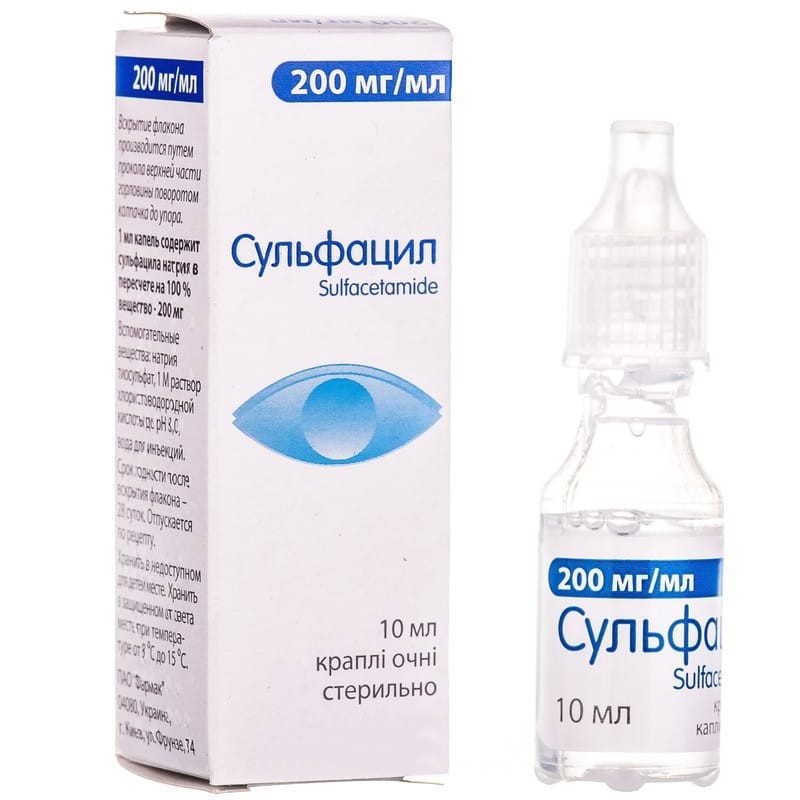



 Secure and encrypted payment processing
Secure and encrypted payment processing We ship to over 40 countries including the USA, UK, Europe, Australia and Japan
We ship to over 40 countries including the USA, UK, Europe, Australia and Japan Guaranteed refund or reship if you haven't received your order
Guaranteed refund or reship if you haven't received your ordersulfacyl has a bacteriostatic effect with respect to gram-positive and gram-negative bacteria - streptococci, pneumococci, gonococci, E. coli, chlamydia, actinomycetes. the mechanism of action of the drug is due to competitive antagonism with pabc and competitive inhibition of dihydropteroate synthetase, which leads to impaired synthesis of tetrahydrofolate acid, necessary for the synthesis of purine and pyrimidine bases. as a result, the synthesis of nucleic acids (dna and rna) of bacterial cells is disrupted and their reproduction is inhibited.
Pharmacokinetics When instilled into the conjunctiva, Sulfacyl penetrates the eye tissue. It acts primarily locally, but part of the drug is absorbed through the inflamed conjunctiva and enters the systemic circulation.
Infectious and inflammatory eye diseases caused by bacteria sensitive to the action of the drug: conjunctivitis, blepharitis, purulent corneal ulcers.
Adults apply a solution of sulfacyl 300 mg / ml, 2-3 drops in the affected eye 5-6 times a day (every 4-5 hours).
For children over 2 months of age, apply Sulfacyl 200 mg / ml, 1-2 drops in the affected eye 4-5 times a day.
The course of treatment is determined by the doctor depending on the nature and severity of the disease. On average, the duration of the course is 7-10 days.
A history of hypersensitivity to the components of the drug and sulfonamides.
Bacterial and fungal corneal ulcers have been reported during treatment with sulfanilamide ophthalmic drugs.
The most commonly reported reactions are local irritation, tingling, and burning. Less commonly, reactions include nonspecific conjunctivitis, conjunctival hyperemia, secondary infection, and allergic reactions.
Rare lethal cases have been recorded due to the development of severe reactions to sulfonamides, including Stevens-Johnson syndrome, toxic epidermal necrolysis, fulminant hepatonecrosis, agranulocytosis, aplastic anemia and other blood disorders.
For local use!
Rare deaths have been reported as a result of serious reactions to sulfonamides, which included Stevens-Johnson syndrome, toxic epidermal necrolysis, fulminant liver necrosis, agranulocytosis, aplastic anemia, and other pathological changes in the blood.
Sensitization may occur with repeated administration of sulfonamides regardless of route of administration. Hypersensitivity reactions have been reported in individuals who do not have a history of hypersensitivity to sulfonamides. At the first sign of hypersensitivity, skin rash, or other serious reactions, you must stop taking this drug.
Long-term use of local antibacterial agents can lead to excessive growth of pathogenic microorganisms, including fungi, as well as to the development of bacteria insensitivity to sulfonamides. The effectiveness of sulfonamides decreases in the presence of high concentrations of PABA in purulent exudate. Sensitization may occur with repeated administration of sulfonamides or as a result of cross-sensitivity between different sulfanilamides.
At the first signs of hypersensitivity, an increase in purulent discharge or an increase in inflammation or pain, the patient should stop using the drug and consult a doctor.
Use during pregnancy and lactation. No animal studies have been conducted regarding the ophthalmic use of sulfa drugs. Nuclear jaundice can occur in newborns as a result of pregnant oral sulfonamides.There are no adequate and well-controlled studies of the use of ophthalmic sulfonamide drugs in pregnant women, and it is not known whether sulfonamides can harm the fetus when taken by a pregnant woman. This drug can be used during pregnancy only if the potential benefit to the woman outweighs the potential risk to the fetus.
The period of breastfeeding. Systemic administration of sulfonamides can lead to nuclear jaundice in newborns whose mothers take sulfonamides during lactation. Due to the possibility of developing nuclear jaundice in newborns, the decision to prescribe sulfanilamides in the form of eye drops for breast-feeding women should be made taking into account the risk / benefit ratio.
Children. Safety and effectiveness of the use of the drug Sulfacyl, eye drops 200 mg / ml, in children under 2 months of age have not been established.
Safety and effectiveness of the use of the drug Sulfacyl, eye drops 300 mg / ml in children have not been established (see APPLICATION).
The ability to influence the reaction rate when driving vehicles or working with other mechanisms. Not investigated.
When combined with Novocaine, tetracaine, benzocaine, the bacteriostatic effect is reduced; diphenin, pask, salicylates increase the toxicity of sulfacyl; when used with indirect anticoagulants, the specific activity of the latter increases. Sulfacyl, when topically applied, is incompatible with silver salts.
With frequent use of the drug, redness, itching, swelling of the eyelids, significant irritation of the mucous membrane of the eye are possible. in this case, treatment is continued with a solution of Sulfacyl of lower concentration, if necessary, the drug is canceled and symptomatic treatment is prescribed.
In the dark place at a temperature of 8-15 ° c.